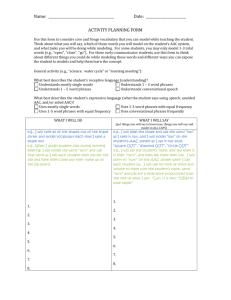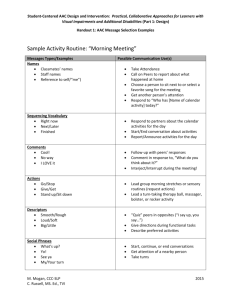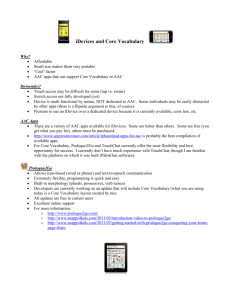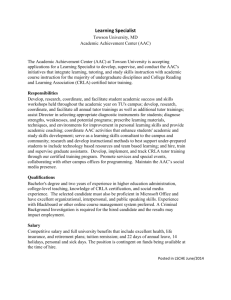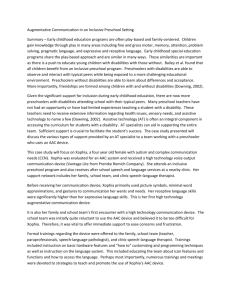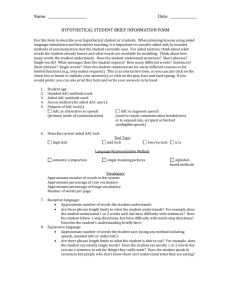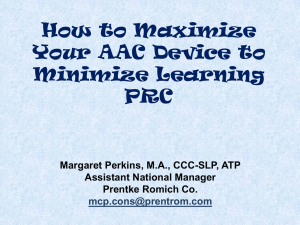AAC Assessment - Gail Van Tatenhove
advertisement
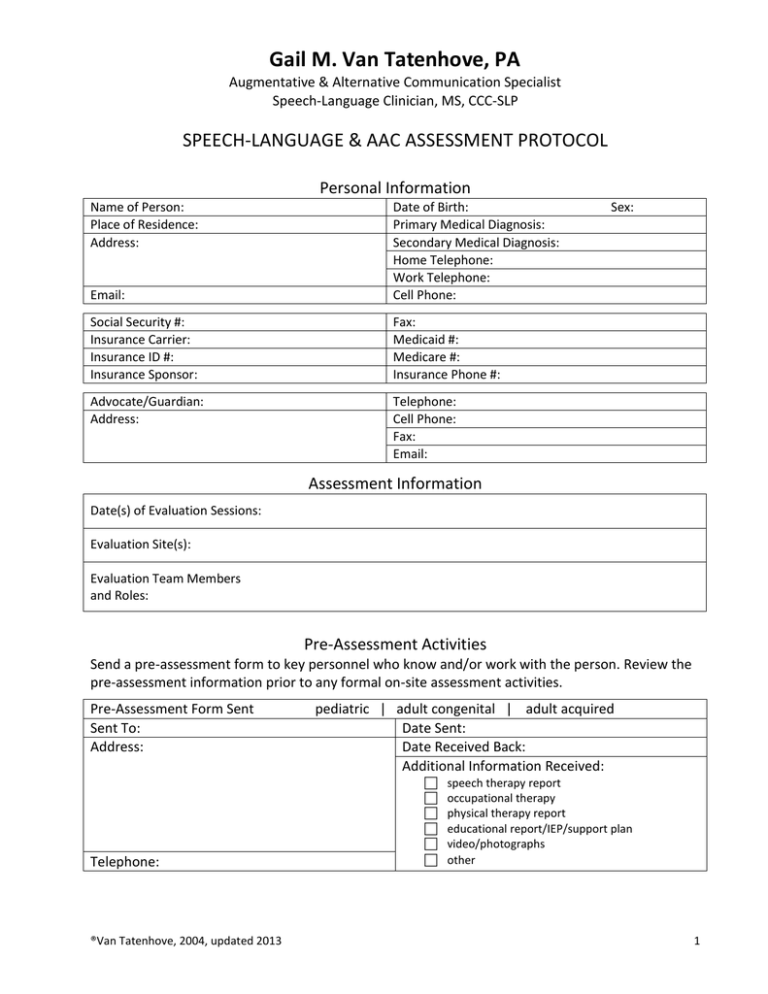
Gail M. Van Tatenhove, PA Augmentative & Alternative Communication Specialist Speech-Language Clinician, MS, CCC-SLP SPEECH-LANGUAGE & AAC ASSESSMENT PROTOCOL Personal Information Name of Person: Place of Residence: Address: Email: Date of Birth: Primary Medical Diagnosis: Secondary Medical Diagnosis: Home Telephone: Work Telephone: Cell Phone: Social Security #: Insurance Carrier: Insurance ID #: Insurance Sponsor: Fax: Medicaid #: Medicare #: Insurance Phone #: Advocate/Guardian: Address: Telephone: Cell Phone: Fax: Email: Sex: Assessment Information Date(s) of Evaluation Sessions: Evaluation Site(s): Evaluation Team Members and Roles: Pre-Assessment Activities Send a pre-assessment form to key personnel who know and/or work with the person. Review the pre-assessment information prior to any formal on-site assessment activities. Pre-Assessment Form Sent Sent To: Address: Telephone: ®Van Tatenhove, 2004, updated 2013 pediatric | adult congenital | adult acquired Date Sent: Date Received Back: Additional Information Received: speech therapy report occupational therapy physical therapy report educational report/IEP/support plan video/photographs other 1 Speech-Language and AAC Assessment Assessment Interview Conduct an interview with available family/caregivers/teachers to confirm and/or clarify information from the pre-assessment form. Include the person who needs AAC if appropriate. Complete any additional protocols, as needed. Record the interview (with permission). Confirm medical information: Confirm perceptual information: o hearing: o vision: o tactile/proprioceptive/motor: o information processing: Record current medications: Confirm history of speech therapy intervention: Confirm history of AAC system use: Confirm current status of AAC system use: Communication needs (attach form): Additional protocols used: o Social Networks: A Communication Inventory for Individuals with Complex Communication Needs and their Communication Partners. (Blackstone & Berg, Attainment Company) o The AAC Profile: A Continuum of Learning (Kovach, LinguiSystems) o The Communication Matrix (Rowland) o Other: Observation of the Person Who Needs AAC If the assessment it being conducted at a natural setting for the person (e.g., home, classroom, worksite), observe the person prior to any formal on-site assessment activities. Videotape the observation (with permission). Observe for the following general areas and record key information: 1. Communication Partners (skilled, unskilled, effective, ineffective) 2. Communication Strategies used (effective and ineffective, signals vs. symbols) 3. Interaction and Engagement with Others (interest, initiation, responses, maintenance) 4. Environmental Factors (space, noise, people) 5. Language Abilities 6. Perceptual Skills 7. Physical Abilities ©Van Tatenhove, 1988, updated 2000, 2013 2 Speech-Language and AAC Assessment Perceptual Skills for Use of an AAC System 1. Vision a. What range/size of pictures and/or text can the person see on an AAC display? b. What is the recommended size based on vision only? c. What visual-perceptual factors need to be implemented (and why) in designing an AAC system? (color coding, color contrasts, spacing, stable surface, inclined surface, perceptual fields, etc.) 2. Hearing a. What, if any, auditory factors needed to be evaluated as part of an AAC assessment? b. What auditory-perceptual factors need to be considered in designing an AAC system (e.g., auditory prompts, auditory feedback, etc.)? Motor Skills for Access of an AAC System 1. Positioning for Access a. Is the person appropriately positioned in his/her wheelchair (or regular/special chair) for maximum function to access an AAC system? NA | yes | no b. If NO, is an expert in positioning included as part of the AAC assessment team? yes | no c. What steps are being taken to ensure that the AAC assessment is being done in consideration of positioning needs? 2. Accessing Activities a. List any access protocols conducted (self-developed, protocols within an AAC device or tablet/app). b. Accessing methods trialed: For each method trialed, describe position of the display, size of display, number and size of targets on the display, ability to access all points on the display, use of a key guard, accuracy in selections, observation of what is happening to the person’s body as he/she accesses the system. Direct Selection via a body part that touches the display (e.g., hand, finger, toe, foot) Direct Selection via a mechanical tool (e.g., head stick, pointer stick, etc.) Direct Selection via infrared pointer / head pointing (e.g., Tracker) Direct Selection via eye pointing/eye gaze ©Van Tatenhove, 1988, updated 2000, 2013 3 Speech-Language and AAC Assessment Scanning o Number of switches: o Type of switch(es): o Location of switch(es:) o Auditory scanning prompts on/off Describe. c. Record the settings at which the person was successful in independently accessing the AAC system (based on options available in the AAC device/app). 3. Describe any use of or need for Partner Assisted Scanning (with a device or on a manual communication board). 4. Motor Planning Observations 5. Recommended Accessing Method Motor Skills for Transportation of an AAC System 1. Current Means of Mobility (circle and describe) walks | walks with assistance/aides | manual wheelchair | power mobility 2. Anticipated Transportation of an AAC System self-carried | carried by others | mounted on wheelchair | attached to walker 3. Self-Carry: Have the person self-carry various AAC systems and observe balance, strength, and mobility in transporting the system. Describe the AAC systems carried, including size, weight, and how well the person could self-carry it. manual communication board | tablet-iPad | dedicated SGD | computer 4. Mounting on a Wheelchair a. Brand of wheelchair: b. Tube width/size: c. Lap tray size: d. Other: 5. Does the person drive a power wheelchair? yes |no If NO, is purchase of a power wheelchair anticipated in the near future? yes | no ©Van Tatenhove, 1988, updated 2000, 2013 4 Speech-Language and AAC Assessment Cognitive Foundations for Use of an AAC System 1. Representational Skills a. The person understands the need and/or value of using an AAC system. immediately (describe evidence): limited, but teachable (describe evidence): does not, even with experience with system (describe evidence): b. The person can use these ways to represent vocabulary: ☐ manual signs/gestures ☐ objects ☐ photographs of people, places, things ☐ pictures for words that are picture producers (e.g., house, car, apple, shoe) ☐ pictures for words that are NOT picture producers (e.g., safe, live, inside) ☐ printed letters ☐ printed words a. The person identifies pictures when: ☐ 1 picture means 1 thing (picture of a house = house) ☐ 1 picture means more than 1 thing (e.g., house = house, home, live, inside) ☐ 1 picture represents a semantic category (e.g., house = buildings) ☐ 1 picture represents a grammatical category of words (e.g., bridge = prepositions) 2. Vocabulary Organization Methods The person, with instruction, was able to retrieve core and extended vocabulary using these vocabulary organizational paradigms. Provide examples of language generated. a. Semantic Compaction/Minspeak® ☐ locates icons on the main display by primary name (e.g., apple, bed, juice, dice) ☐ identifies a logical icon for a noun concept (e.g., food, furniture, beverage, game) ☐ identifies a logical icon for a verb concept (e.g., eat, sleep, drink, play) ☐ identifies a logical icon for an adjective concept (e.g., hungry, tired, thirsty) ☐ completes a two-part icon sequence using previously identified icons ☐ select vocabulary from an activity row (e.g., drinks, foods, toys) ☐ produces a simple phrase (e.g., eat food, drink juice, play toys) ©Van Tatenhove, 1988, updated 2000, 2013 5 Speech-Language and AAC Assessment b. Page-Based Navigations ☐ locates pictures on the main display by primary name ☐ locates categorical pictures that navigate to other pages ☐ identifies pictures on various pages ☐ produces a simple phrase with words on 1 page ☐ produces a simple phrase with words on 2 or more pages c. Word Prediction ☐ spells initial letters correctly ☐ selects the correct word from a word prediction display ☐ selects from grammatical prediction options ☐ selects from predictive sentence building (predict next word in sentence) options 3. Vocabulary Generation The person, with instruction, was able to …. (provide examples of language generated): a. ☐ Select a picture + part-of-speech or part-of-speech + picture to say a word b. ☐ Select a picture for a category + picture to say a word from that category c. ☐ Select a word from a pop-up and/or activity row to generate language d. ☐ Navigate to more vocabulary in an activity row to generate language e. ☐ Navigate to pages to select vocabulary to generate language f. ☐ Navigate from a page back to a main display to continue generating language g. ☐ Navigate from page to page to generate language 4. What are your impressions of the person’s ability to learn to use various strategies for representing, organizing and retrieving vocabulary independently. Address attention, learning style, short-term memory, following sequences/navigations, etc. 5. What was observed in terms of the influence of motor planning and motor automaticity in vocabulary retrieval and the generation of language? ©Van Tatenhove, 1988, updated 2000, 2013 6 Speech-Language and AAC Assessment Speech Skills 1. The person is aware when his/her speech is not understood? yes | no | maybe | don’t know 2. The person is showing signs of communication frustration when depending on his/her speech to communicate? yes | no | maybe | don’t know Describe: 3. The person is intelligible …. a. to familiar people on a known topic usually | often | sometimes | rarely b. to familiar people on an unknown topic usually | often | sometimes | rarely c. to unfamiliar people on a known topic usually | often | sometimes | rarely d. to unfamiliar people on an unknown topic usually | often | sometimes | rarely 4. What strategies does the person use to help communication partners understand his/her speech? Include examples. a. ☐ repeats b. ☐ slows down c. ☐ adds gestures/signs/pointing d. ☐ spells initial letters for misunderstood words e. ☐ uses a related word/concept f. ☐ other: 5. If the person has some intelligible speech, describe WHY the person needs an AAC system? Who wants the AAC system? When will it be used? Receptive Language Abilities 1. Responds to name yes | no 2. Engages in choice making for familiar, favorite objects yes | no 3. Answers yes/no questions a. ☐ To identify common objects (e.g., Is this a shoe?) b. ☐ About preferences (e.g., Do you like candy?) c. ☐ To confirm/deny (e.g., Did you like that? Is this what you wanted?) 4. Understands single word vocabulary a. Report results of past vocabulary testing (e.g., PPVT) b. ☐ Identifies objects by label ©Van Tatenhove, 1988, updated 2000, 2013 7 Speech-Language and AAC Assessment c. ☐ Demonstrates understanding of basic verbs (e.g., go, sit, stand, eat, play, swim) d. ☐ Demonstrates understanding of basic adjectives (e.g., big, little, hot, cold) e. ☐ Demonstrates understanding of basic prepositions (e.g., in, out, over, under) f. ☐ Demonstrates understanding of /wh/ concepts (e.g., who, what, when, where) 5. Understands variations in syntax and morphology a. ☐ Understands negation (e.g., Where is the person not eating? Show me where the boy isn’t crying.) b. ☐ Understands verb morphology (e.g., Show me where the boy is eating. Show me where the boy will eat. Show me where the boy ate.) c. ☐ Understands pronouns (e.g., Show me where she is eating. Show me where they are eating.) d. ☐ Understands plurality (e.g., Show me an apple. Show me apples. Show me children. Show me a child.) e. ☐ Understands adjective morphology (e.g., Show me the biggest one.) 6. Follows directions (within the person’s physical abilities. List examples.) a. ☐ Follows 2-step directions b. ☐ Follows 3-step directions Expressive Language Output 1. Unintentional behaviors (vocalizing, body language, yelling, pinching) are primary means for people to interpret feelings and needs? yes | no Give examples. Behavior Interpreted Meaning 2. Intentional communication signals (e.g., vocalizing, pointing, giving, showing, directing, pantomime, etc.) are primary means of communicating? yes | no Describe. ©Van Tatenhove, 1988, updated 2000, 2013 8 Speech-Language and AAC Assessment 3. Does the person have a current means of producing generative language? yes | no a. If yes, does the system have automated data collection? yes | no b. If YES, have you collected and analyzed a language sample? yes | no If YES, what language sample analysis tools did you use? PeRT | SALT | Other: c. If no, what AAC system(s) will be used to assess expressive language? (Make sure the system used provides the ability to develop simple generative language, using nouns, verbs, adjectives, prepositions, pronouns, etc.) manual communication boards (describe, include photo with report) speech generating devices (list name of device(s) and vocabulary programs used) tablet with apps (list tablet type and names of apps) 4. Describe the instructional strategies used to support expressive language output during the assessment? Note the person’s response to these strategies. partner modeling: visual cueing: verbal cueing: visual support materials: other: 5. Samples of Language Produced (attached a data log, if available) spontaneous | with supports ________________________________________________ spontaneous | with supports ________________________________________________ spontaneous | with supports ________________________________________________ spontaneous | with supports ________________________________________________ spontaneous | with supports ________________________________________________ spontaneous | with supports ________________________________________________ spontaneous | with supports ________________________________________________ spontaneous | with supports ________________________________________________ spontaneous | with supports ________________________________________________ spontaneous | with supports ________________________________________________ ©Van Tatenhove, 1988, updated 2000, 2013 9 Speech-Language and AAC Assessment 6. Describe the generative language produced by the person. a. Number of utterances analyzed _______ b. MLU-M = __________ Which of Brown’s Stages of Language Development? ______ c. Development of the noun phrase (describe): d. Development of the verb phrase (describe): 7. Would you describe the person as an “emerging communicator,” “context-dependent communicator” or an ”independent-generative communicator”? 8. Communication Functions: Provide opportunities for the person to communicate for a range of communication functions. a. gave opportunity to greet took | passed | describe: b. gave opportunity to part took | passed | describe: c. gave opportunity to give information took | passed | describe: d. gave opportunity to request information took | passed | describe: e. gave opportunity to request assistance took | passed | describe: f. gave opportunity to request recurrence took | passed | describe: g. gave opportunity to request action took | passed | describe: h. gave opportunity to make a comment took | passed | describe: i. gave opportunity to deny/negate took | passed | describe: j. gave opportunity to direct actions took | passed | describe: k. gave opportunity to state possession took | passed | describe: Social & Strategic Communication Skills 1. Seeks the attention of others for the purpose of communication? yes | no Describe. 2. Engages in joint attention with a communication partner? yes | no Describe. 3. Responds to the communication of others? yes | no Describe. 4. Initiates communication with others? yes | no Describe. 5. Stays on topic during conversations? yes | no Describe. ©Van Tatenhove, 1988, updated 2000, 2013 10 Speech-Language and AAC Assessment 6. Takes turns in a conversation? yes | no Describe. 7. Attempts to repair communication breakdowns? yes | no Describe. 8. Switches between communication strategies, as needed? yes | no Describe. 9. Alternates message length/style based on communication partner and communication situation? yes | no Describe. 10. Other: AAC System Trials List the aided AAC systems tried. Make sure you ethically consider ALL of the major types of aided AAC systems, such manual communication boards, Minspeak® systems, page-based systems, and mobile technologies/apps. Videotape ALL system trials, with permission. Hardware and Vocabulary Program MCB SGD APP 1. 2. 3. 4. 5. 1. System Trial 1: _________________________________________ Length of Time: ___________ a. Describe activity b. Target vocabulary c. Outcomes and objective data log d. Impressions ©Van Tatenhove, 1988, updated 2000, 2013 11 Speech-Language and AAC Assessment 2. System Trial 2: _________________________________________ Length of Time: ___________ a. Describe activity b. Target vocabulary c. Outcomes and objective data log d. Impressions 3. System Trial 3: _________________________________________ Length of Time: ___________ a. Describe activity b. Target vocabulary c. Outcomes and objective data log d. Impressions 4. System Trial 4: _________________________________________ Length of Time: ___________ a. Describe activity b. Target vocabulary c. Outcomes and objective data log d. Impressions 5. System Trial 5: _________________________________________ Length of Time: ___________ a. Describe activity b. Target vocabulary c. Outcomes and objective data log d. Impressions ©Van Tatenhove, 1988, updated 2000, 2013 12 Speech-Language and AAC Assessment Teams Recommendations 1. AAC System 2. Vocabulary Program/App 3. Access Method 4. Transportation Method 5. Instructional Supports 6. Communication Partner Training Discussion of Recommendations with Person and Key Personnel 1. The person agrees with the recommendation for the AAC system, vocabulary program/app, access method, and transportation method. yes | no Describe. 2. The caregivers/family agree with the recommendation for the AAC system, vocabulary program/app, access method, and transportation method. yes | no Describe. Next Steps (Discuss and list the next steps to be taken in order to implement the recommendations.) ©Van Tatenhove, 1988, updated 2000, 2013 13

